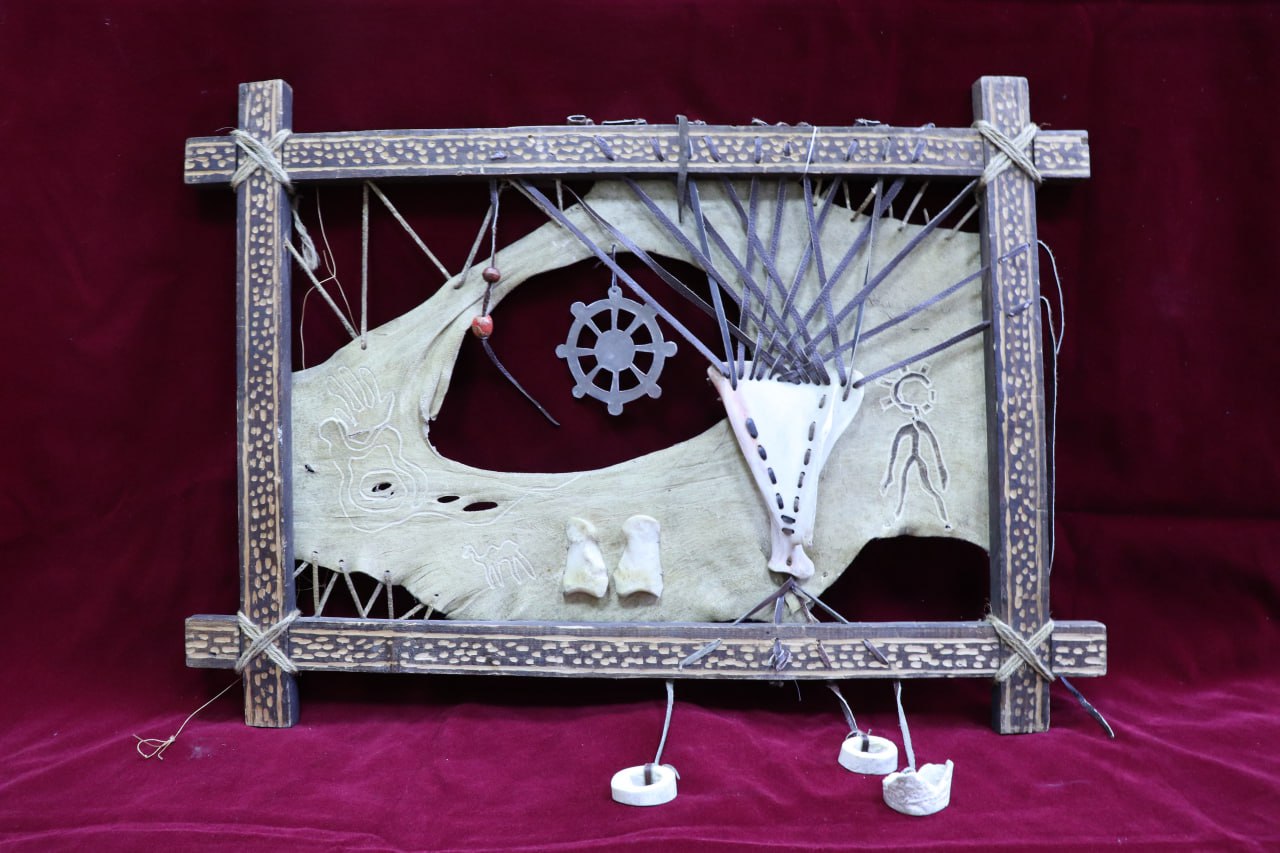
The art of bone carving
The continuation of bone-carving traditions can also be observed in the ancient Turkic era. Valuable evidence of Kazakh traditional bone-carving craftsmanship has been found during excavations in Otrar and other ancient towns.
Kazakh craftsmen in the art of bone carving were called süyekshi. Bones from animals such as horns, shoulder blades, shins and ribs from cattle, horses, camels, sheep and saigas were used as material. The material was accumulated over the winter, and fat cattle bones were usually used, as they were more elastic and better able to be carved. By various manipulations they were adjusted to the carving.
Horns were used to make handles daggers, thongs and knives. Sheep horns were used to make vessels for storing tobacco, shaqsha, and cattle horns were used to make a ladle for pouring koumiss, ozhau. Various objects have been made from bone but mainly bone and horn have been used for inlaying. Bone or horn inlay has a pleasant yellow colour, reminiscent of amber. The material itself (bone and horn) is semantically linked to the ideas of death and the eternal life contained within it.
For example, elaborately carved bone plates decorated many pieces of furniture. For example, bone plates were skillfully carved on many pieces of furniture, such as a bed – tösekağash, a wooden box for storing food – kebezhe, an asadal cupboard and a sandyq chest. The door of the yurt, called sykyrlauyk, as well as the bases of uyq dome poles and the upper part of sağanak latticework slats were also inlaid. The dombyra and qobyz, musical instruments made of wood, wer particularly lovingly inlaid.
The Russian Museum of Ethnography (St.Petersburg) holds a unique specimen of a Kazakh door, richly decorated with bone plates. This artefact can safely be classified as a masterpiece. The “bone”, openwork ornaments literally cover the entire surface of the door.
In the olden days and nowadays, Kazakhs still make a shümek, a tube through which a baby’s urine is led out of the cradle. At the same time, the shümek is a family relic, which, like the cradle besik, is often handed down from generation to generation.
At one “Sheber” artisan competition, two masters made a gift set of shümek tubes for infants. The set also included rattles made of lamb’s bones and silver beads, and was packaged in an original shape in the form of a traditional cradle – besik. The authors of such exclusive items were craftsmen Bolat Beysbekov and Erkosai Abilov.
A creative interpretation of the ancient nomadic art can be found in the works of the renowned master bone carver Bektas Karimula, a native of the Bayan-Ulgiy aimag of Mongolia.
The main material for a master carver is the shovel bone zhauryn, which still has a sarcastic meaning in the minds of the Kazakhs. This bone was traditionally served to the most respected guest. The Kazakhs, like other nations, had soothsayers zhaurynshi, who were able to see the signs on the shovel of the future events: jute (steppe murrain), migrating, weather changes and more.
Just a few years ago Kainarbek Ernazaruly from Pavlodar joined the craft, and recently he has begun teaching it to schoolchildren as well.
Another folk craftsman is Zhomart Malik, a bone carver from Karaganda region, and his father taught him the craft. He combines the bone details with wood and leather, and also uses animal horns, hooves and teeth. This combination of materials has become his trademark. The master is actively promoting his craft, offering free workshops every week and already has many students.
Ongarbai Baimakhan, a craftsman from Aralsk, is also famous for his mastery of bone carving. His father taught him the basics of his craft. He makes articles of bone and horns of domestic animals. Knife handles, jewellery, combs, statuettes and figurines, trinkets, sets of board games are in great demand among customers.
Another well-known master, of whom the people say: segyz qyrly, bir syrly, is Abylaihan Asylbai from the East Kazakhstan region. The point is that the master is a chaser, blacksmith, jeweler, skin carver and bone carver. To sum up, there need to say that Kazakh artisans in most cases are versatile and work with various materials. That’s why sometimes it is hard to determine main specialization of a craftsman/skilled worker.
Omirkeldy Abeuov, a resident of the town of Balkhash, makes a huge contribution to the development of Kazakh traditional crafts. He can be described as a versatile master of painting, wood and bone carving, the art of making shym shi mats and tapestries.
The traditions of the Kazakh bone carving art, but already in a new format, are represented by the work of Ruslan Junusov, a well-known painter, sculptor, master-cutter of miniature wood and bone sculptures, member of the Union of Artists of Kazakhstan. The artist creates unique miniature sculptures from wood and bone, the main plot of which is constructed on images of the Kazakh epos, heroes of fairy tales and myths.
Generally, the art of bone carving in Kazakhstan, which was almost extinct in the recent past, still demonstrates its potential and relevance today. However, without purposeful work in this area by the state, NGOs and other organisations, it may fade away.




